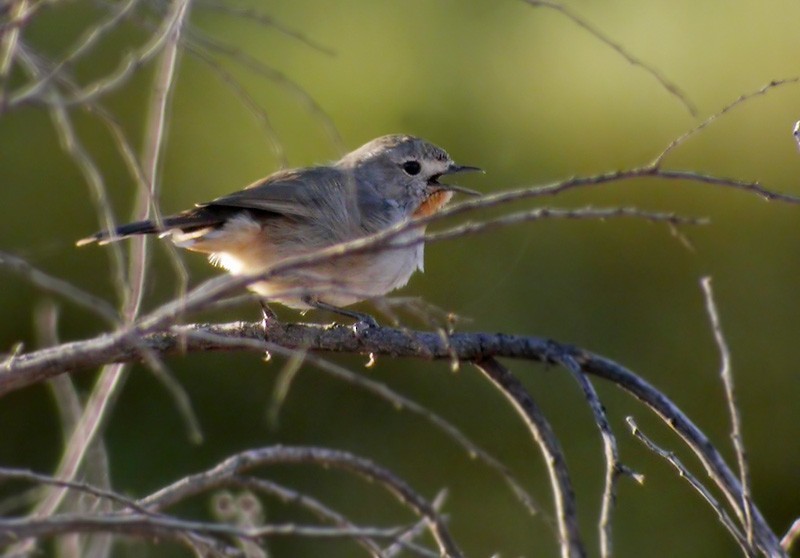Redthroat
A species of Redthroat and Speckled Warbler Scientific name : Pyrrholaemus brunneus Genus : Redthroat and Speckled Warbler
Redthroat, A species of Redthroat and Speckled Warbler
Botanical name: Pyrrholaemus brunneus
Genus: Redthroat and Speckled Warbler
Content
Description General Info
 Photo By Lars Petersson
Photo By Lars Petersson Description
A small 11–12 cm (4.3–4.7 in) shy greyish-brown bird, the redthroat is most often seen swiftly darting through low branches and shrubs or hopping mouse-like on the ground. Only adult males have the distinctive small, rusty-brown throat patch, which gives the species its common name and the absence of which makes the identification of females and juveniles more difficult. The upper part of the head, body, wings, and tail are a dark brownish-grey, particularly dark on the rump and tail. While the underbody is predominantly whitish-grey, with a more whitish belly and pale buff colour blending into the flanks and undertail-coverts. The tail has prominent white patches on the tips of the outer feathers, which can be seen during flight and with the tail folded. Fine off-white scalloping is visible on the forehead, with off-white eye rings and lores merging into the lighter underparts of the body. It may be confused with some thornbill species, which are more compact with a shorter tail than the redthroat. It is unlikely to be mistaken for fieldwrens or heathwrens, which have a more strongly upturned tail at rest. The melodious call, similar to that of a canary, has sustained warbling and loud cheery notes. In addition to its own calls, the redthroat is able to mimic the calls of numerous other birds, including the pied butcherbird, rufous fieldwren, grey fantail, fairywrens, and thornbills. The redthroat has even been known to mimic the non-vocal sound of whistling wingbeats made by a crested pigeon in flight. Although both sexes call throughout the year, during the breeding season male calls are more sustained. The species is vocal when foraging and will also sing while perched atop shrubs and taller trees. 
Size
13 cm
Nest Placement
Ground
Feeding Habits
Redthroat primarily consumes a varied diet of arthropods and seeds, including beetles, flies, cicadas, ants, and seeds from chenopods and other genera. Redthroat forages alone or in groups, gleaning from low vegetation or sallying into the air, often joining mixed-species flocks for feeding.
Habitat
Redthroat thrives in arid to semi-arid environments, inhabiting diverse shrublands and woodlands. This includes areas with acacia overstory and saltbush or bluebush understory, often near watercourses and across inland plains and ranges. Adaptability is evident as redthroat also frequents mallee heathlands and eucalypt woodlands with dense shrub layers.
Dite type
Insectivorous
General Info
Feeding Habits
Bird food type
Behavior
Redthroats are omnivores with a diet consisting of seeds from grasses and shrubs as well as a broad variety of invertebrates, such as spiders, insects, and gastropods. Observations of redthroat foraging behaviour found that the species predominantly forages at heights of less than 1m (73% of observations) and was not observed foraging at heights greater than 3m. This study found that redthroats feed mostly by pouncing on prey from the ground or gleaning in low vegetation, with very few instances of hunting on the wing. Another study of foraging behaviour found that all observations of foraging occurred on the ground (<0.1 m), using a combination of gleaning and probing. 
Distribution Area
The redthroat is endemic to mainland Australia, occurring in all states and territories, except the Australian Capital Territory and Tasmania. The species is most prevalent in Western Australia and South Australia. It has a widespread but scattered distribution throughout most of South Australia. In Western Australia, the species is not present in the far north or the south-east, but is prevalent throughout the mid-latitudes of the state. In the Northern Territory, the species is restricted to the south of the state, around the Simpson Desert and the MacDonnell Ranges. In Queensland, the species is restricted to inland south-western regions. In Victoria, the species is restricted to the mallee regions in the northwest of the state. In New South Wales, the species is only known to occur in the far west, in several core populations, including Broken Hill, Tibooburra, Penarie and Nearie Lake Nature Reserve. The species is thought to be mostly sedentary, with no evidence to suggest seasonal migration. Individuals recaptured after banding have all been found within 10 kilometres (6.21 mi) of the banding site. 
Species Status
Populations of redthroats have declined in many areas throughout Australia and the species is subject to many threatening processes. This has warranted its conservation listing in New South Wales and Victoria as follows: The redthroat is listed as threatened on the Victorian Flora and Fauna Guarantee Act (1988). Under this Act, an Action Statement for the recovery and future management of this species has not yet been prepared. On the 2013 advisory list of threatened vertebrate fauna in Victoria, the redthroat is listed as endangered. The redthroat is listed at vulnerable under the NSW Threatened Species Conservation Act (1995) In New South Wales, several threatening processes affecting redthroat populations have been formally identified, including the following: Clearing of suitable vegetation communities can cause range contractions and isolate populations. Overgrazing by feral herbivores, particularly goats, can cause habitat degradation and prevent habitat regeneration for the species. The infestation of suitable habitat by the noxious environmental weed Mesquite also impacts habitat values and foraging resources. Given that redthroats are predominantly ground-dwelling and nesting birds, they are also highly susceptible to predation by exotic predators, such as foxes and cats. Although the species is not yet federally listed under the Environment Protection and Biodiversity Conservation Act 1999, the threatening processes listed above are present throughout most of the species distribution. The ongoing impacts of land clearing, noxious weeds, introduced herbivores, and introduced predators are likely to cause further declines throughout the species range, which may warrant further environmental protection measures. 

 Photo By Lars Petersson
Photo By Lars Petersson